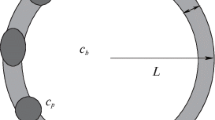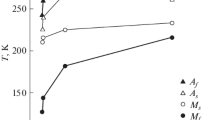Abstract
Analysis of dispersoid formation and stability indicates that in-situ formation of an adequate volume fraction of fine particles can be thermodynamically incompatible with stability against high-temperature coarsening. The theory of particle coarsening is extended to include the effects of grain boundaries and dislocations. Theoretical analysis predicts that particle dragging by migrating grain boundaries combined with enhanced coarsening by grain boundary diffusion can give denuded regions near grain boundaries. These predictions of enhanced coarsening and particle dragging are in accord with experimental observations on α-Ti and Ti3Al based alloys.
Similar content being viewed by others
References
G.S. Ansell, ed., Proc. Second Bolton Landing Conference on Oxide Dispersion Strengthening, New York, Gordon & Breach, 1968.
J.W. Martin, “Micromechanisms in Particle Hardened Alloys,” Cambridge University Press, Cambridge, 1980.
S. Wolf and N.J. Grant, “Structure-Property Relationships in Oxide-Dispersed Iron-Beryllia Alloys,” Powder Metallurgy International, 9 (1971), pp. 57–64.
H. Jones, “Rapid Solidification of Metals and Alloys,” The Institution of Metallurgists, London, 1982.
F.H. Froes, Y-W. Kim and F.J. Hehmann, “Rapid Solidification of the Light Metals,” Journal of Metals, 39 (8) (1987) pp.14–21.
K.C. Russell, Y-W. Kim and F.H. Froes, “Terminal Solid Solubility Extension Under Rapid Solidification,” Proceedings of Indo-USA Workshop on Rapid Solidification Principles, R.K. Trivedi, ed., Office of Naval Research (in press).
A.R. Miedema, P.F. de Chatel and F.R. de Boer, “Cohesion in Alloy—Fundamentals of a Semi-Empirical Model,” Physica, 100B (1980), pp. 1–28.
S.J. Savage and F.H. Froes, “Production of Rapidly Solidified Metals and Alloys,” Journal of Metals, 36 (4) (1984), pp. 20–23.
M. Kahlweit, “Ostwald Ripening of Precipitates,” Adv. Coll. Int. Sci., 5 (1975), pp. 1–35.
C. Wagner, “Theorie der Alterung von Niederschlagen durch Umlosen,” Z. Elektrochem., 65 (1961), pp. 581–591.
I.M. Lifshitz and V.V. Slyozov, “The Kinetics of Precipitation from Supersaturated Solid Solutions,” J. Phys. Chem. Solids, 19 (1961), pp. 35–56.
S.K. Bhatttacharyya and K.C. Russell, “Activation Energies for the Coarsening of Compound Precipitates,” Met. Trans., 3 (1972), pp. 2195–2199.
M.V. Speight, “Growth Kinetics of Grain Boundary, Precipitates,” Acta Met., 16 (1968), pp. 133–135.
H.O.K. Kirchner, “Coarsening of Grain Boundary Precipitates,” Metall. Trans., 2 (1970), pp. 2861–2864.
A.J. Ardell, “On the Coarsening of Grain Boundary Precipitates,” Acta Met., 20 (1972), pp. 601–609.
E. Hart, “On the Role of Dislocations in Bulk Diffusion,” Acta Metall., 5 (1957), p. 597.
H.B. Aaron and H.I. Aaronson, “Growth of Grain Boundary Precipitates in Al-4% Cu by Interfacial Diffusion,” Acta Metall., 16 (1968), pp. 789–798.
F.H. Froes and R.G. Rowe, “Rapidly Solidification Titanium,” Rapidly Solidified Alloys and Their Mechanical and Magnetic Properties, Vol. 58, B.C. Giessen, D.E. Polk and A.I. Taub, eds., Materials Research Society, Pittsburgh, PA (1986), pp. 309–334.
P.G. Shewmon, “The Movement of Small Inclusions in Solids by a Temperature Gradient,” Trans. Met Soc. AIME, 230 (1964), pp. 1134–1137.
M.F. Ashby and I.G. Palmer, “The Dragging of Solid Particles Through Metals by Migrating Grain Boundaries in Copper,” Acta Met., 15 (1968), pp. 420–423.
E.F. Koch and K.T. Aust, “The Movement of Solid Particles in a Solid,” Acta Met., 15 (1967), pp. 405–409.
M.F. Ashby and R.M.A. Centamore, “The Dragging of Small Oxide Particles by Migrating Grain Boundaries in Copper,” Acta Met., 16 (1968), pp. 1081–1092.
H.I. Aaronson and K.C. Russell, “Nucleation—Mostly Homogeneous and in Solids,” Solid-Solid Phase Transformations, H.I. Aaronson, D.E. Laughlin, R.F. Sekerka and C.M. Wayman, eds., TMS-AIME, Warrendale, PA (1983), pp. 371–397.
M.F. Ashby, “The Influence of Particles on Boundary Mobility,” Recrystallization and Grain Growth of Multiphase and Particle Containing Materials, N. Hansen, A.R. Jones and T. Leffers, eds., Roskilde, Denmark (1978), pp. 325–336.
K.C. Russell and F.H. Froes, “Compound Dispersoid Stability on Grain Boundaries,“ Scripta Met. (in press).
A.K. Niessen and F.R. de Boer, “The Enthalpy of Formation of Solid Borides, Carbides, Nitrides, Suicides and Phosphides of Transition and Noble Metals,” J. Less Comm. Met., 82 (1981), pp. 75–80.
A.K. Niessen, F.R. de Boer, R. Boom, P.F. de Chatel, W.C.M. Mattens and A.R. Miedema, “Model Predictions for the Enthalpy of Formation of Transition Metal Alloys II,” Calphad, 7 (1983), pp. 1–70.
A.R. Miedema and F.J.A. den Broeder, “On the Interfacial Energy in Solid-Liquid and Solid-Solid Metal Combinations,” Z Metall., 70 (1979), pp. 14–20.
R. Warren, “Solid-Liquid Interfacial Energies in Binary and Psuedo-binary Systems,” J. Mat. Sci., 15 (1980), pp. 2489–2496.
J. Askill, Tracer Diffusion Data for Metals, Alloys, and Simple Oxides, ITF/Plenum, New York.
A.M. Brown and M.F. Ashby, “Correlations for Diffusion Coefficients,” Acta Metall., 28 (1980), pp. 1085–1101.
E.D. Hondros, “Interfacial Energies and Compositions in Solids,” Precipitation Processes in Solids, K.C. Russell and H.I. Aaronson, eds., TMS-AIME, Warrendale, PA (1978), pp. 1–30.
S.H. Whang, “Rapidly Solidified Ti Alloys for High Temperatures Applications,” J. Mat Sci., 21 (1986), pp. 2224–2238.
D.G. Konitzer and H.L. Fraser, “The Production and Thermal Stability of a Refined Dispersion of Er2O3 in Ti3Al Using Rapid Solidification Processing,” Plasma Processing and Synthesis of Materials, J. Szekely and D. Apelian, eds., New York, Elsevier Publishing (1985), pp. 437–442.
R.G. Rowe, J.A. Sutliff and E.F. Koch, “Comparison of Melt Spun and Consolidated Ti3Al-Nb Alloys With and Without a Dispersoid,” Titanium Rapid Solidification Technology, F.H. Froes and D. Eylan, eds., Warrendale, PA, TMS-AIME (1986), pp. 239–248.
R.G. Rowe, J.A. Sutliff and E.F. Koch, “Dispersoid Modification of Ti3Al−Nb Alloys,” Rapidly Solidified Alloys and Their Mechanical and Magnetic Properties, Vol. 58, B.C. Giessen, D.E. Polk and A.I. Taub, eds., Materials Research Society, Pittsburgh, PA (1986), pp. 359–364.
J.A. Sutliff and R.G. Rowe, “Rare Earth Oxide Dispersoid Stability and Microstructural Effects in Rapidly Solidified Ti3Al and Ti3Al−Nb,” Rapidly Solidified Alloys and Their Mechanical and Magnetic Properties, Vol. 58, B.C. Giessen, D.E. Polk and A.I. Taub, eds., Materials Research Society, Pittsburgh, PA (1986), pp. 371–376.
M.F.X. Gigliotti, R.G. Rowe, G.E. Wasielewski, G.K. Scarr and J.C. Williams, “Tensile and Creep Properties of Rapidly Solidified Titanium Alloys Containing Complex Matrices and Fine Dispersoids,” Rapidly Solidified Alloys and Their Mechanical and Magnetic Properties, Vol. 58, B.C. Giessen, D.E. Polk and A.I. Taub, eds., Materials Research Society, Pittsburgh, PA (1986), pp. 343–351.
S.H. Whang, Y.Z. Lu and B.C. Giessen, “Thermal Stability of Precipitates in a Rapidly Quenched Ti−Al−Si Alloy,” Rapidly Solidified Materials, B.H. Kear and B.C. Giessen, eds., Elsevier Publishing, New York (1984), pp. 367–373.
Additional information
K.C. Russell received his Ph.D. in metallurgical engineering from the Carnegie Institute of Technology in 1964. He is currently a professor in the Departments of Materials Science and Engineering and Nuclear Engineering at the Massachusetts Institute of Technology. Dr. Russell is also a member of TMS.
F.H. Froes received his Ph.D. in physical metallurgy from the University of Sheffield, England. He is currently Branch Chief, U.S. Air Force Materials Laboratory, Structural Metals Branch, Wright-Patterson Air Force Base, Ohio, Dr. Froes is an adjunct professor at the University of Dayton and Wright State University. He is also a member of TMS.
Rights and permissions
About this article
Cite this article
Russell, K.C., Froes, F.H. Dispersoid Formation and Stability in Alloys. JOM 40, 29–35 (1988). https://doi.org/10.1007/BF03258938
Published:
Issue Date:
DOI: https://doi.org/10.1007/BF03258938




